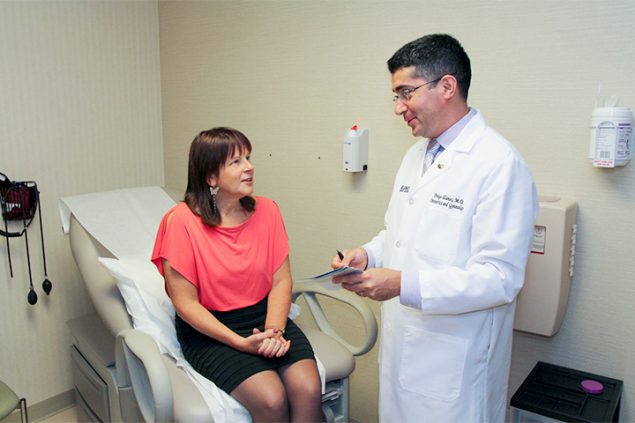Success Story: Leveraging Information Technology to Empower Patients
Reliant Medical Group, Worcester, Massachusetts (2015)
In previous rounds of the Hypertension Control Challenge, Million Hearts® established a benchmark of 70% hypertension control for applicants’ adult populations. This 2015 success story reflects the earlier benchmark.
The Challenge
Reliant Medical Group, a multi-specialty group practice, cares for more than 300,000 patients across more than 20 locations in central Massachusetts. In 2010, Reliant launched an effort to better control high blood pressure among its patients. Identifying which patients were truly hypertensive proved to be a significant challenge.
Reliant Medical Group used a Harvard Pilgrim Health Care grant to study how blood pressure was being recorded across its numerous locations. The data showed that the frequency of patients’ blood pressure readings tended to spike on multiples of 10, such as 120, 130, or 140. The team discovered that roughly half of blood pressure readings were being rounded up or down to the nearest 10, casting doubt on the accuracy of readings.
What They Did
Used evidence-based strategies
In response, Reliant created standard operating procedures for accurately measuring blood pressure and distributed digital blood pressure monitors to all its primary care sites. Reliant hypothesized that digital monitors would make it easier for the health care team to record accurate readings. The team continued to collect and graph data on blood pressure readings. Soon, Reliant began to see dramatic results.
“After we got the digital cuffs, we evened [blood pressure measurements] out much more so that [staff] weren’t rounding to the nearest 10,” said Lawrence Garber, MD, medical director for informatics at Reliant. “It’s very striking.”
Leveraged health information technology to provide better, more cost-effective care
After this initial success, the Reliant team tackled the challenge of controlling patients’ high blood pressure. In a pilot study funded by the Agency for Healthcare Research and Quality, Reliant gave digital home blood pressure monitors to 200 of its prediabetic and diabetic patients. Several times a week, patients measured and uploaded their blood pressure readings into their electronic health record. Nurses regularly reviewed patients’ data and adjusted the amount of blood pressure medicine based on a protocol. If a patient’s medicine did not seem to be working, the nurse would talk with a physician about switching to a different medication.

“Engaging patients and letting them become empowered to participate in their blood pressure monitoring has been a very positive thing.”
—Ken Kronlund, MD, quality chief of adult primary care, Reliant Medical Group
Photo: Dr. Diego Illanes of Reliant Medical Group (right) confers with a patient.
Signs of Success
Reliant found that mildly hypertensive patients with home digital cuffs were more likely to get their blood pressure under control than similar patients without home monitoring. This was especially true for hypertensive patients with a systolic pressure of 160 mmHg or lower.
Dr. Garber said that this group can easily be overlooked if they see a doctor only once every 6 months. “If a person comes into my office and their blood pressure is 152 and we talk about it and [they say] they hit traffic on the way…I might write it off,” said Dr. Garber.
But with more frequent readings, nurses and doctors can see that someone consistently has high blood pressure, even when they are in a relaxed setting at home., he said: “It’s a lot more obvious when someone has slightly elevated blood pressure and thus we were treating them more appropriately.”
Reliant found that not only did home monitors help identify patients with uncontrolled hypertension, but the digital cuffs can help patients control their blood pressure more quickly than patients without home monitoring can.
“The patient can get several medication [adjustments] between the time I see them initially and when I see them at a 6-month follow-up,” said Ken Kronlund, MD, quality chief of adult primary care at Reliant. “It’s so much smoother and more aggressive [as a medication adjustment] process than we had 10 years ago. [Before,] you might spend years trying to treat someone with modestly elevated blood pressure.”
Now, anyone at Reliant who is diagnosed with hypertension is linked to a nurse right away. “In days of old, it would be, ‘Your blood pressure is high; see me in 6 months,’ and now it’s, ‘Your blood pressure is high; talk to the nurse three to six times before I see you next,’” said Dr. Kronlund. Patients can either purchase or borrow a home monitor to track their blood pressure as their medication is adjusted.
What They Accomplished
Through a combination of accurate measuring, home monitoring, and nurse, clinical pharmacist, and health coach feedback and support, Reliant transformed blood pressure care and control in its patient population. Reliant now has a hypertension control rate of 79% in its adult population and is consistently in the top 90% of blood pressure control rates compared with other health care systems across the country.
Advice for Others
A key part of the program was allowing patients to visit the practice without a copay. The health care team answered questions about medicines, discussed diet and exercise, and counseled patients on how to adhere to their medicines.
“This has to be convenient for the patient, and doctors can’t become the bottleneck in moving patients forward in their treatment,” said Dr. Garber. In order to facilitate this process, Reliant developed medication protocols that are available to all 250 physicians in their medical group.
And how do the patients feel about tracking their health?
“They gleefully bring in more data than I ever wanted—blood pressure readings at multiple times a day,” said Dr. Kronlund. “Engaging patients and letting them become empowered to participate in their blood pressure monitoring has been a very positive thing.”
